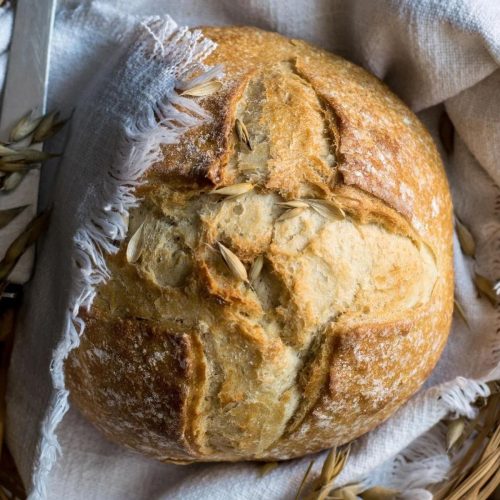Dutch Oven Bread Loaf
Embrace the art of bread making with this Dutch Oven Bread Loaf recipe, delivering homemade perfection. This easy-to-follow guide unlocks the secrets to a crusty, flavorful loaf that's as delicious as it is beautiful.
Elevate your baking game and savor the joy of freshly baked goodness! This one is bound to impress.
Substitutions
- Yeast - When choosing the type of yeast for your baking, follow the recipe's instructions, as the type of yeast can affect rising times and flavor. You can often substitute one type of yeast for another, but you may need to adjust rising times or quantities slightly. If a recipe calls for active dry yeast and you want to use instant/fast-rising yeast instead, you can typically use about 25% less fast-rising yeast and reduce the rising time by about 10-15 minutes. To learn more about the various types of yeasts, please see question 1 in the FAQ section.
-
Gluten Free - Making a gluten-free Dutch oven bread loaf can be a bit different from making traditional wheat-based bread due to the absence of gluten, which provides structure and elasticity to bread. But, it's still possible to create a delicious gluten-free loaf with a good crust using alternative flours.
- Make sure you find a gluten-free flour blend suitable for bread. The flour ratio is usually 1:1 with normal flour but use the recommended ratio on the gluten-free flour packaging.
- I'd also suggest adding 1-1.5 cups worth of a complimentary gluten-free nut flour blend (like almond or coconut flour) to add structure and flavor to your loaf.
- Gluten acts as a natural binder in wheat-based bread, so in gluten-free bread, you might need to add binding agents like xanthan gum or guar gum to help with texture and structure. Typically, you'll use ½ to 1 teaspoon of xanthan gum per cup of gluten-free flour.
- Gluten-free flours absorb moisture differently than wheat flour. You may need to adjust the liquid-to-dry ingredient ratio to achieve the right dough consistency. Start with the recipe's recommended ratio and add more liquid if the dough is dry.
FAQ
- What are the differences between the various types of yeasts? There are several types of yeast that can be used in baking, each with its characteristics and applications. Here are the most common types of yeast used in baking:
-
Active Dry Yeast:
- Active dry yeast is one of the most widely used types of yeast in baking. It needs to be dissolved in warm water before using.
- It has a slightly longer activation time compared to instant yeast but can be used in a wide range of recipes, including bread, rolls, and pizza dough.
- It has a longer shelf life when stored in a cool, dry place.
-
Instant Yeast (Fast-Rising Yeast):
- Instant yeast, also known as fast-rising yeast or quick-rise yeast, doesn't require proofing in warm water.
- It can be added directly to the dry ingredients in a recipe, which can save time in the baking process.
- It activates quickly and is suitable for bread, rolls, pizza dough, and many other baked goods.
-
Fresh Yeast (Cake Yeast or Compressed Yeast):
- Fresh yeast is a moist yeast that comes in the form of a cake or block.
- It requires refrigeration and has a shorter shelf life compared to dry yeasts.
- Fresh yeast is less commonly used by home bakers but is sometimes preferred in commercial baking for its unique flavor contributions.
-
Sourdough Starter (Wild Yeast):
- Sourdough starter is a mixture of flour and water that captures wild yeast from the environment.
- It's used to make sourdough bread and other sourdough-based products.
- Sourdough starter requires regular feeding and maintenance and can develop complex flavors over time.
-
Brewer's Yeast and Nutritional Yeast:
- Brewer's yeast and nutritional yeast are not typically used for leavening but are used for their nutritional benefits and flavor.
- Brewer's yeast is often used as a supplement and has a slightly bitter taste.
- Nutritional yeast has a savory, cheesy flavor and is commonly used as a topping or seasoning for dishes like popcorn and vegan cheese substitutes.
- Do you need to activate the yeast separately before adding into other dry ingredients? Normally yes you would, but in this recipe I was able to mix all the dry ingredients together, add the warm water, mix, cover, rest, and still have this beautiful loaf. So you don't need wait for any frothing of the yeast. If you want to be sure your yeast is active though, I suggest adding it straight to the warm water separately prior to adding to remaining dry ingredients.
Storage
To store a freshly baked Dutch oven loaf and keep it fresh for as long as possible, follow these steps:
- Cool Completely: Allow the Dutch oven loaf to cool completely at room temperature before storing it. This usually takes 1-2 hours. Cooling is essential to prevent condensation inside the storage container, which can make the crust soggy.
-
Wrap or Cover: Once the bread has cooled, you have a few options for storing it:
- Bread Bag: Place the bread in a bread bag or a clean, breathable cloth bag designed for storing bread. Avoid using plastic bags as they can trap moisture and make the crust soft.
- Paper Bag: Wrapping the bread in a paper bag or using a paper towel to cover it can also help maintain the crust's texture. This method is suitable for short-term storage.
- Bread Box: If you have a bread box with good ventilation, you can store the loaf in it. Bread boxes are designed to keep bread fresh by maintaining the right level of humidity.
- Cotton Towel: You can wrap the bread in a clean cotton kitchen towel and secure it with a rubber band or twine. This method can help preserve the crust.
- Store at Room Temperature: Keep the wrapped or covered bread at room temperature in a cool, dry place, away from direct sunlight, heat sources, and moisture. I usually put in a Ziplock bag and set on my kitchen countertop. Avoid storing it in the refrigerator, as it can accelerate staling.
- Use within a Few Days: Dutch oven bread is best when consumed within 2-3 days of baking for the freshest taste and texture. As time passes, the bread may become slightly less crisp on the outside, but it should still be delicious.
- Reheat as Needed: If you want to refresh the bread or enjoy it warm, you can reheat individual slices or the entire loaf in a preheated oven at 350°F (175°C) for about 10 minutes. This can help revive the crust and make the bread taste freshly baked.
You can store a Dutch oven loaf in the freezer for up to 2-3 months if properly wrapped and stored.
- Cool Completely: Allow the baked Dutch oven loaf to cool completely at room temperature before freezing. If you freeze it while still warm, it can create condensation inside the packaging, which may affect the texture of the bread.
-
Wrap Tightly: Wrap the bread tightly to prevent freezer burn and moisture loss. You have a few options:
- Double-wrap the loaf in plastic wrap. Ensure it's sealed tightly to minimize air exposure.
- Place the wrapped loaf in a heavy-duty freezer bag and remove as much air as possible before sealing.
- Use aluminum foil to wrap the bread tightly.
- Store in Freezer: Place the wrapped and labeled Dutch oven loaf in the coldest part of your freezer to maintain its quality.
- Thawing: When you're ready to enjoy the bread, remove it from the freezer and let it thaw at room temperature. This may take a few hours to several hours, depending on the size of the loaf. You can also reheat slices or the entire loaf in the oven for a few minutes to freshen it up.
Dutch Oven Bread Loaf
Rated 3.5 stars by 64 users
Servings
1 loaf
Prep Time
3 hours
Cook Time
45 minutes
Can you imagine me showing up at your house with this loaf of bread?!

Ingredients
- 3 cups all purpose flour
- 2 teaspoons activated yeast
- 2 teaspoons salt
- 12 oz of water
- Optional: Aerosmith soundtrack
Directions
In a large mixing bowl, combine the all-purpose flour, salt, and activated yeast.
Add in the warm water. Mix everything together until a shaggy dough forms. You can use a wooden spoon or your hands for this step.
NOTE: If you want to be sure your yeast is activated, add the activated yeast to the warm water separately from the dry ingredients first. Let it sit for about 5-10 minutes until it becomes frothy. This indicates that the yeast is active and ready to use. Then you can mix with the other dry ingredients.
Once the dough comes together, cover the bowl with a clean kitchen towel or plastic wrap and let it rest in a warm place for about 2-3 hours, or until the dough has doubled in size.
Gently punch down the dough to release any air bubbles.
Preheat your conventional oven to 450°F (232°C) and place a Dutch oven with a lid into the conventional oven while it's preheating.
On a flat flour-covered surface, shape the dough into a round or oval shape depending on your preference. Use flour on your hands generously to get the shape you want without it sticking to you.
Time to get crafty! Carve a little slit into the dough along the side to give it the crevaces that you can see in my photo.
Once the oven is preheated, carefully remove the hot Dutch oven (use oven mitts). Place the dough onto a piece of parchment paper and then place the parchment paper with the dough into the Dutch oven.
Put the lid back on the Dutch oven and bake for 30 minutes in conventional oven.
After 30 minutes, remove the lid and continue baking for an additional 10-15 minutes, or until the bread is golden brown and sounds hollow when tapped on the bottom.
Carefully remove the bread from the Dutch oven using the parchment paper as a handle.
Allow the bread to cool on a wire rack before slicing and serving.
Go show off your loaf ya'll!
Recipe Note
Equipment
1 Dutch Oven 5 Quart
